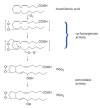Oxidation of polyunsaturated fatty acids to produce lipid mediators
- PMID: 32618335
- PMCID: PMC7517362
- DOI: 10.1042/EBC20190082
Oxidation of polyunsaturated fatty acids to produce lipid mediators
Abstract
The chemistry, biochemistry, pharmacology and molecular biology of oxylipins (defined as a family of oxygenated natural products that are formed from unsaturated fatty acids by pathways involving at least one step of dioxygen-dependent oxidation) are complex and occasionally contradictory subjects that continue to develop at an extraordinarily rapid rate. The term includes docosanoids (e.g. protectins, resolvins and maresins, or specialized pro-resolving mediators), eicosanoids and octadecanoids and plant oxylipins, which are derived from either the omega-6 (n-6) or the omega-3 (n-3) families of polyunsaturated fatty acids. For example, the term eicosanoid is used to embrace those biologically active lipid mediators that are derived from C20 fatty acids, and include prostaglandins, thromboxanes, leukotrienes, hydroxyeicosatetraenoic acids and related oxygenated derivatives. The key enzymes for the production of prostanoids are prostaglandin endoperoxide H synthases (cyclo-oxygenases), while lipoxygenases and oxidases of the cytochrome P450 family produce numerous other metabolites. In plants, the lipoxygenase pathway from C18 polyunsaturated fatty acids yields a variety of important products, especially the jasmonates, which have some comparable structural features and functions. Related oxylipins are produced by non-enzymic means (isoprostanes), while fatty acid esters of hydroxy fatty acids (FAHFA) are now being considered together with the oxylipins from a functional perspective. In all kingdoms of life, oxylipins usually act as lipid mediators through specific receptors, have short half-lives and have functions in innumerable biological contexts.
Keywords: fatty acid metabolism; lipid mediators; polyunsaturated fatty acids.
© 2020 The Author(s).
Conflict of interest statement
The authors declare that there are no competing interests associated with the manuscript.
Figures















References
-
- Gurr M.I., Harwood J.L., Frayn K.N., Murphy D.J. and Michell R.H. (2016) Lipids: biochemistry, biotechnology and health, 6th edn, Wiley/Blackwell, Oxford
Publication types
MeSH terms
Substances
LinkOut - more resources
Full Text Sources

